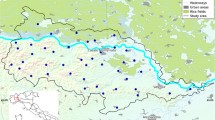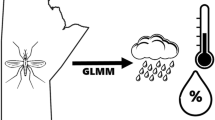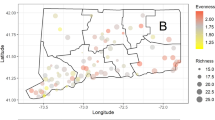Abstract
For two metropolitan New Jersey counties, monthly average adult mosquito (Culex) catch from New Jersey light trap data sets covering multiple decades is related to a number of meteorological factors. From June through August climatological conditions accounted for between 40% and 50% of the variation in average catch. In general, high monthly precipitation totals both in the month corresponding to the catch and the previous month were associated with increased trap catch. However, individual heavy rainfall events tended to reduce catch. Warm temperatures exerted a positive influence on mosquito abundance in June, but were associated with a low catch in August. Linear meteorological relationships explained only a small percentage of the variations in mosquito catch during May and September. During July, and particularly August, antecedent monthly catch also explained a significant portion of the variance in the contemporaneous catch. Over 60% of the variability in August catch could be attributed to the July population.







Similar content being viewed by others
References
Alexandersson H (1986) A homogeneity test applied to precipitation data. J Climatol 6:661–675
Andreadis TG, Anderson JF, Vossbrinck CR (2001) Mosquito surveillance for West Nile virus in Connecticut, 2000: isolation from Culx pipiens, Cx. restuans, C. salinarius, and Culiseta melanura. Emerg Infect Dis 7:670–674
Barker CM, Reisen WK, Kramer VL (2003) California state mosquito-borne virus surveillance and response plan: a retrospective evaluation using conditional simulations. Am J Trop Med Hyg 68:508–518
Cayan D, Tyree M, Dettinger M (2002) Climate linkages to female Culex tarsalis abundance in California. Proc Mosq Vector Control Assoc Calif 70:15–19
Day JF, Curtis GA (1989) Influence of rainfall on Culex nigripalpus (Diptera: Culicidae) blood-feeding behavior in Indian River county, FL. Ann Entomol Soc Am 82:32–37
Hacker CS, Scott DW, Thompson JR (1973) Time series analysis of mosquito population data. J Med Entomol 10:533–543
Hess AD, Cherubin CE, LaMotte LC (1963) Relation of temperature to activity of western and St. Louis encephalitis viruses. Am J Trop Med Hyg 12:657–667
Perreault L, Hache M, Slivitzky M, Bobee B (1999) Detection of changes in precipitation and runoff over eastern Canada and U.S. using a Bayesian approach. Stochastic Environ Res Risk Assess 13:201–216
Raddatz RL (1982) Forecasts of Culex tarsalis populations in Winnipeg, Manitoba. In: Sekla L (ed) Western equine encephalitis in Manitoba. Manitoba Health Services Commission, Winnipeg, Manitoba
Raddatz RL (1986) A biometeorological model of an encephalitis vector. Bound Layer Meteorol 34:185–199
Reeves WC, Hardy JL, Reisen WK, Milby MM (1994) Potential effect of global warming on mosquito-borne arboviruses. J Med Entomol 31:323–332
Reinert WC (1989) The New Jersey light trap: an old standard for most mosquito control programs. In: Proceedings of the seventy-sixth annual meeting of the New Jersey Mosquito Control Association, pp 17–25
Reisen WK, Eldridge BF, Scott TW, Gutierrez A, Takahashi R, Chapin T, Lorenzen K, DeBenedictis J, Boyce K, Swartzell R (2001) Comparison of dry ice-baited CDC and NJ light traps for measuring mosquito abundance. Proc Mosq Vector Control Assoc Calif 69:9–12
Sellers RF, Maarouf AR (1988) Impact of climate on western equine encephalitis in Manitoba, Minnesota and North Dakota, 1980–1983. Epidemiol Infect 101:511–535
Wegbreit J, Reisen WK (2000) Relationships among weather, mosquito abundance and encephalitis virus activity in California: Kern county 1990–1998. J Am Mosq Control Assoc 16:22–27
Wilks DS (1995) Statistical methods in the atmospheric sciences. Academic, San Diego
Acknowledgements
This work was supported by the National Oceanic and Atmospheric Administration, National Climatic Data Center under contract EA1330-02-RP-0011. The work is part of the National Climate Impacts Indicator Program. The guidance of Dr. Laura Harrington and Ms. Renee Anderson concerning the entomological aspects of this work is greatly appreciated. Thanks are also extended to Mr. Rod Schmidt, Mr. Tony Acquaviva and Ms. Lisa Reed for providing the mosquito trap data.
Author information
Authors and Affiliations
Corresponding author
Rights and permissions
About this article
Cite this article
DeGaetano, A.T. Meteorological effects on adult mosquito (Culex) populations in metropolitan New Jersey. Int J Biometeorol 49, 345–353 (2005). https://doi.org/10.1007/s00484-004-0242-2
Received:
Revised:
Accepted:
Published:
Issue Date:
DOI: https://doi.org/10.1007/s00484-004-0242-2




